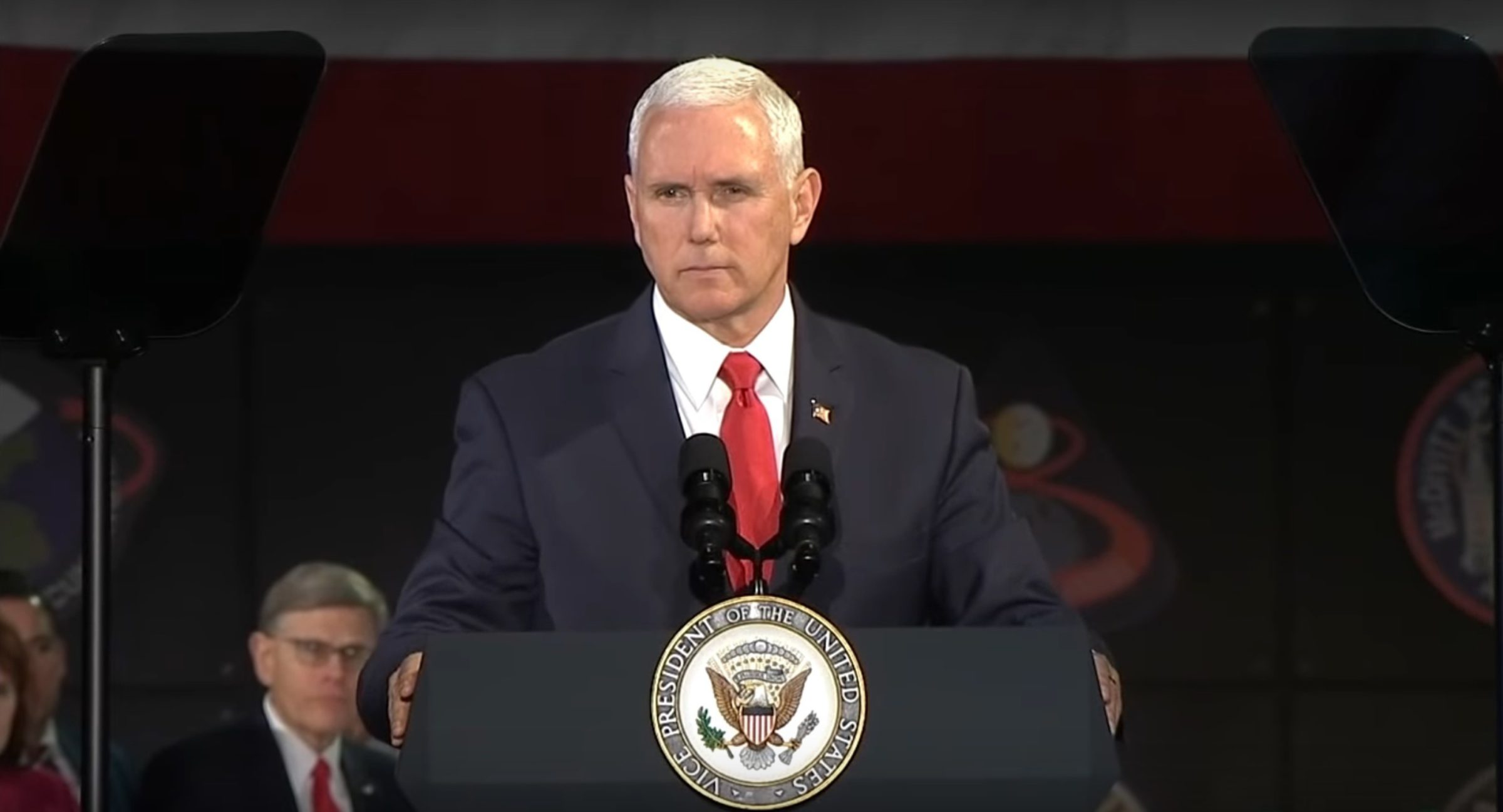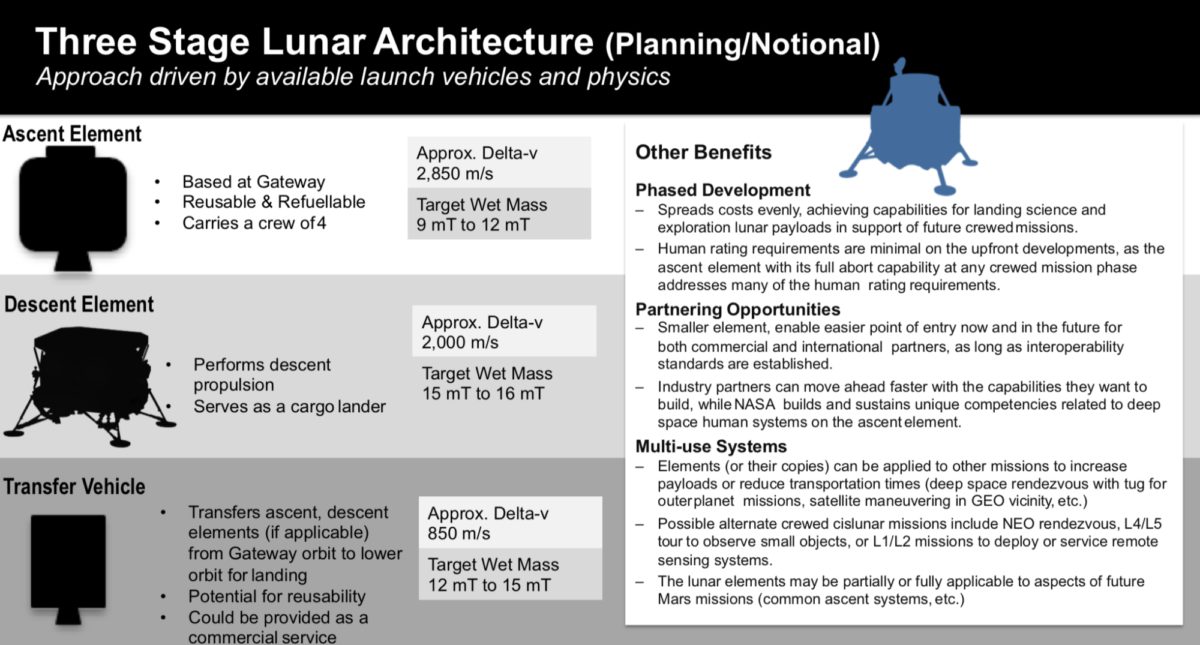Casey Dreier • Apr 04, 2019
T-minus Five Years and Counting
In an unprecedented speech to the National Space Council in March, Vice President Mike Pence rebuked NASA and its major contractors for their "complacency" in returning Americans to the Moon. He announced that President Trump decided to accelerate human lunar landings to 2024, four years faster than planned, and that he told NASA "to accomplish this goal by any means necessary."
If you don't know what to make of this announcement, you are not alone. Just weeks before Pence's speech, the White House released a budget request for NASA that enshrined a 2028 lunar surface return with an orbiting lunar space station, the Gateway. It also proposed nearly half a billion dollars in cuts to the space agency.

It is not clear what precipitated this sudden acceleration of NASA's lunar timeline, but frustration in the face of mounting delays in the SLS rocket program is a likely source. Originally scheduled to have its first flight test in 2017, ongoing development issues and quality control problems have pushed the first uncrewed test of SLS and Orion to least 2021, with the first crewed test around the moon in 2023. The Vice President made a thinly-veiled warning to the SLS's prime contractor, Boeing, in his speech:
To reach the Moon in the next five years, we must select our destinations now. NASA already knows that the lunar South Pole holds great scientific, economic, and strategic value. But now it's time to commit to go there.
But to accomplish this, we must redouble our efforts here in Huntsville and throughout this program. We must accelerate the SLS program to meet this objective. But know this: The President has directed NASA and Administrator Jim Bridenstine to accomplish this goal by any means necessary.
If our current contractors can't meet this objective, then we'll find ones that will. If American industry can provide critical commercial services without government development, then we'll buy them. And if commercial rockets are the only way to get American astronauts to the Moon in the next five years, then commercial rockets it will be.
Naturally, the speech incited reactions in the space community ranging from delighted to cynical. Congressional Democrats in the House of Representatives are questioning the motivations behind the new timeline, asking how they could fund a crash program without a clear sense of what NASA is trying to do and given that the White House had just weeks before proposed cuts to NASA's budget.
NASA Administrator Jim Bridenstine assured congressional leaders that NASA will provide a new plan to reach the lunar surface by 2024 with a supplemental budget request submitted to Congress by mid-April.
How seriously are we to take this announcement? Look to the supplemental request. If we see a significant increase in funding, we should take it seriously. If not, we can't. Rhetoric is cheap. The billions of dollars necessary to accelerate a lunar program are not.
Listen to Casey Dreier and Brendan Curry, the Planetary Society's Chief of Washington Space Operations, discuss the 2024 lunar landing goal in this episode of the Space Policy Edition of Planetary Radio.
But even if the money shows up, there are a number of reasons to be skeptical about the 2024 timeline. There are also a few reasons to be optimistic. And it is at this point that my “Chief Advocate” self and my “Policy Adviser” self part ways. My advocate self very much wants this to happen, but my skeptical policy self considers it unlikely.
Reasons to be Skeptical
The Timeline
Five years is not a lot of time. When John F. Kennedy called for the nation to land a man on the Moon and return him safely to the Earth, his advisers recommended a timeline of “before the decade is out” in order to give NASA some additional slack and to shift a possible failure into the next Presidency (his second term would have ended in 1968).
From his announcement in April of 1961, NASA had approximately 8 ½ years to develop, test, and validate the necessary hardware and methods for getting astronauts onto the Moon and safely returning them home. They succeeded, but had the money and the political consensus that enabled them to do so. But they also had 3½ more years than NASA does now. Granted NASA is much more capable now than in 1961, but many of the same deficiencies exist: there is no functional heavy-lift rocket, no functional spacecraft for deep space, and no lunar lander even under formulation. Humans haven't been beyond low Earth orbit in 47 years. NASA now has five years to change that.
The Hardware
Human-rated space hardware is extremely complex and is subject to significant oversight in terms of safety and reliability. The last time NASA successfully designed, tested, and flew human-rated space hardware in less than five years was during the Apollo program.
Obviously, NASA has far more knowledge and experience for placing humans in space than it did in 1961, but it is primarily for operations in a low Earth orbit environment. Necessary hardware such as the SLS and Orion are still in the development and testing phase, not production, and a lunar lander project will have to ramp up from effectively zero. Even if NASA uses public-private partnerships to develop a lunar lander, all one needs to do is look at the commercial crew program to be reminded that this strategy provides no magic bullet for the timely development of crew-capable spacecraft.
The availability of commercial rockets, however, is a notable difference compared to the early 1960s, though size and mass constraints will be a real issue as they primarily serve customers in low Earth orbit. The Falcon Heavy is currently not rated to fly important NASA payloads, and though rockets like SpaceX's Super Heavy and Blue Origin's New Glenn should exist in coming years, for now, they don't.
The Money
The year after Kennedy's speech to Congress, NASA's budget nearly doubled. In 1963 it doubled again. It eventually peaked in 1965 at roughly $42 billion in today's dollars, with the majority of funds supporting Project Apollo. Yet political support waned by the mid-1960s and effectively vanished by the end of the decade. NASA's budget tumbled as a result. The funding level was unsustainable.
I have no idea how much it will cost to accelerate a lunar landing to 2024. No one does. NASA is working on it, and we will see how much they expect it to cost (or, more accurately, what they're allowed to ask for) when they submit a supplemental budget request next month. Whatever the increase, it must be sustained over the next five years (or longer to build up a permanent presence) for there to be any hope of success.
Given the upcoming clashes on overall levels of government spending, particularly given the number of proposed cuts for issues important to the Democratic party and the return of the automatic budget cuts of the sequester this year, it will be a difficult slog to get a budget at all—much less one that significantly increases NASA funding.
The Politics
The sudden interest in accelerating this program is itself a worrying sign for how long this attention will last. Could the president lose interest just as quickly? It's not impossible, particularly if the cost estimates turn out to be high. Fortunately, vice president Pence is a stabilizing force in the White House, which should help maintain focus.
There is also the possibility that lavishing funds on NASA while proposing cuts to other agencies could create political hostility to the effort. I have also written about the political risks of tying a policy proposal tightly to a President because it can incite partisan opposition. Congressional Democrats, who now run the House of Representatives, have already expressed skepticism at the sudden change of pace, and it remains to be seen if significant opposition materializes from the opposing party, as it did against the Space Exploration Initiative under George H.W. Bush.
There is also the fact that not so long ago NASA was shut down with the majority of its 18,000 employees furloughed without pay for five weeks. The immigration issue that drove that shutdown has not yet been resolved, and is likely to return again. NASA can only move so fast when it is subject to arbitrary closures, furloughs, and short-term budget extensions.
Reasons to be optimistic
The Politics
Regardless of one's personal opinions of the current executive branch leadership, they demonstrate a real and ongoing interest in space issues. In the past, presidents have dropped into a NASA center, made soaring speeches about space, and then moved on. Vice President Pence, on the contrary, has shown ongoing interest in the space program. His March speech demonstrates that he is closely following NASA's progress and is willing to express his (and the president's) displeasure. This sort of public pressure is unprecedented in recent history and has the potential to push the workforce of NASA and its contractors to perform better.
In addition, a Republican president has the ability to marshal his party in Congress to support domestic spending measures in a manner impossible for a Democratic president, by the very nature of their partisan alignment (or unalignment). If spending-averse members of Congress do not resist increased funding for NASA due to their alignment with their party's president, NASA is more likely to gain the additional resources necessary to enable this effort.
The Commercial Sector
“If commercial rockets are the only way to get American astronauts to the Moon in the next five years, then commercial rockets it will be,” said the vice president. Commercial rockets are indeed in the cards, and a new generation of launch vehicles are just around the corner.
Competition between companies for fixed-price or milestone-based contracts for lunar landers, crew vehicles, or other related components could help speed up development, particularly if NASA steps back and lessens its direct oversight. This doesn't guarantee success by any means. Again, look at the struggles of Boeing and SpaceX for commercial crew. But it's a new factor at play. Is there a new way of doing business at the Moon? Maybe! One of the lunar lander concepts currently being explored by NASA is a 3-stage spacecraft that is partially reusable and can fit onto commercial rockets. Again this doesn't ensure success, but it presents new pathways to get there.

To the Moon
Landing on the Moon by 2024 won't be easy, but it's not impossible. That's an important distinction.
It's important to step back and recognize that the president of the United States stated that NASA should “use any means necessary” to achieve a rapid goal of returning to the Moon. This doesn't happen often. We will know in April if he is serious about this or not, based on whether the money shows up (and it has to be additional funding, not money taken from NASA's science and aeronautics projects). Should that happen, the proposal must make it through a skeptical Congress and make it through quickly in order to begin the project in earnest. Building the political coalition to support this endeavor will be no easy task.
So I remain skeptical, and so should you. Many times in the last 50 years have the hopes and dreams of space advocates been dashed by the practical difficulties of politics. But I will allow myself to feel a little optimistic until we know for sure otherwise. It's okay to feel excited about the future.
Let’s Go Beyond The Horizon
Every success in space exploration is the result of the community of space enthusiasts, like you, who believe it is important. You can help usher in the next great era of space exploration with your gift today.
Donate Today

 Explore Worlds
Explore Worlds Find Life
Find Life Defend Earth
Defend Earth

